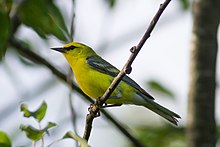Blue-winged warbler
| Blue-winged warbler | |
|---|---|
 |
|
| Adult male in Maine, United States | |
| Scientific classification | |
| Kingdom: | Animalia |
| Phylum: | Chordata |
| Class: | Aves |
| Order: | Passeriformes |
| Family: | Parulidae |
| Genus: | Vermivora |
| Species: | V. cyanoptera |
| Binomial name | |
|
Vermivora cyanoptera Olson & Reveal, 2009 |
|
 |
|
| Range of V. cyanoptera
Breeding range Winter range |
|
| Synonyms | |
|
Vermivora pinus |
|
Breeding range Winter range
Vermivora pinus
Helmintophila pinus
The blue-winged warbler (Vermivora cyanoptera) is a fairly common New World warbler, 11.5 cm (4.5 in) long and weighing 8.5 g (0.30 oz). It breeds in eastern North America in southern Ontario and the eastern United States. Its range is extending northwards, where it is replacing the very closely related golden-winged warbler, Vermivora chrysoptera.
The common name blue-winged warbler refers to the bluish-gray color of the wings that contrast with the bright yellow body of the male. The name of the genus Vermivora means "worm-eating". The genus used to include nine other new world warblers but now includes only the golden-winged warbler and Bachman's warbler which is believed to be extinct.
The blue-winged warbler was one of the many species originally described by Linnaeus in his 18th-century work, Systema Naturae, though the scientific name has changed several times. The species epithet Pinus was given by Linnaeus in 1766 but was a mistake as the original description of the species was actually based on illustrations of "pine creepers" drawn by others. The drawings depicted two different species, what we now call a pine warbler and blue-winged warbler. In 2010 the blue-winged warbler's scientific name was changed by the American Ornithologists Union to correct the error. Pine warblers retained the species name Pinus but the species epithet for blue-winged warbler was changed to cyanoptera.
This species forms two distinctive hybrids with golden-winged warbler where their ranges overlap in the Great Lakes and New England area. The more common and genetically dominant Brewster's warbler is gray above and whitish (male) or yellow (female) below. It has a black eye stripe and two white wing bars. The rarer recessive Lawrence's warbler has a male plumage which is green and yellow above and yellow below, with white wing bars and the same face pattern as male golden-winged. The female is gray above and whitish below with two yellow wing bars and the same face pattern as female golden-winged.
...
Wikipedia

